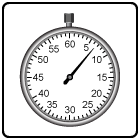


START
LESSON
GO TO THE GAMES
Click on the correct answer.
You will see the left side of an equation. Then you will see and hear two possible answers for the right side of that equation.
Click on the correct answer.
There are 10 questions in this test.
to start the lesson

anonymous 😍😍
"Recognize a sequence"
Elementary math lessons to learn
'Is the number odd or even?' for 2nd grade
2nd grade / Comparing numbers / Odds and evens 20 to 100 / Is the number odd or even?
Decide if the number is odd or even for numbers from 20 to 100
If we count up the numbers from 1 to 10 we get a list like this:
1, 2, 3, 4, 5, 6, 7, 8, 9, 10..
There are 2 types of numbers in that list. Half of them are "even" numbers and half of them are "odd" numbers.
We can understand the difference between odd and even numbers by thinking about pairs of things. Some things come in pairs, like socks, shoes or gloves. You need 2 of them (a pair) because you have two hands and two feet. Some numbers can make a pair, and some cannot. 2 is a pair (having 2 shoes is having a pair of shoes). Another number that makes a pair is 4, because 2 twos add together to make 4 without anything left over. The same for 6 and 8 and 10. These are the even numbers.
Other numbers can't make a pair without something left over. 3 is like that. If you try to make a pair from 3, you find that you have a pair of ones but there is one left over. This type of number is called odd. The other odd numbers in our list are 1, 5, 7 and 9.
This topic asks you to identify which numbers are odd and which are even. The numbers you will see are between 20 and 100, but it doesn't matter how big the numbers are because you only actually need to look at the last digit of the number, and decide if it is odd or even. Any number whose last digit is even is an even number. Any number whose last digit is odd is an odd number.
Here are some example questions from this topic:
Question : Is 52 odd or even? Answer : even
The answer is even because the last digit of 52 is 2 and you know that 2 is an even number.
Another example question is:
Question : Is 47 odd or even? Answer : odd
The answer is odd because the last digit of 47 is 7, and you know that 7 is an odd number.
With these interactive math lessons you will be learning "Is the number odd or even?" from
2nd grade / Comparing numbers in 3 easy steps. The math in our lessons consists of 6 questions that ask you to choose whether these numbers from 20 to 100 are odd or even.
There are 3 easy math lesson activities in this "Is the number odd or even?" tutorial. These activities progress step by step to help you the learner gradually master this math topic. The activities are based on "3 stage questioning", a method of learning that quickly and easily builds your confidence as you work through the short series of lessons that strengthen your knowledge of the math that you want to learn.
When you have completed the tutorial for a topic, you should try some of our games before finally doing the test for your chosen topic. See the Help box below for detailed instructions on how to use the lesson activities to help you learn your math more easily.
UXO * Duck shoot * The frog flies * Pong * Cat and mouse * The beetle and the bee
Rock fall * Four in a row * Sow grow * Choose or lose * Mix and match





How to use our tutorials to learn
'Is the number odd or even?' for 2nd grade
Introduction to the math topic
You start the tutorial with a lesson that introduces the math you will be learning. You will see a set of questions one at a time, and for each question you will see the written answer and also hear the answer to that question.
Repeat the question/answer by clicking on the brown speaker sign. Repeat the question/answer and expand the question graphic by clicking on the question box. Move between questions using the arrow buttons below the question. If there is additional information available for your chosen topic, the "i" button on the left upright bar will be brown on white. Click on the button to load the additional lesson information into the main interface.
Either / Or math lesson
This lesson moves on from the "Introduction" lesson and offers you two possible answers to each question. So, you will see a question then a voice will ask "Is this ... or is it ..." and you will have to choose which of the answers is the one that matches the question.
You choose an answer by clicking or tapping on one of the two answer boxes below the question. You can play the audio for each answer again by clicking on the speaker icon beside the written answer (if robot speech is available and enabled). The program will let you know each time whether you answered correctly. A star will light up red for a wrong answer or white/black for a correct answer.
This lesson asks you the questions in a random order compared to the introduction. At the end of the lesson, you can choose whether to repeat the lesson or move on to the next one.
What is it? math lesson
The final lesson of the tutorial shows you multiple possible answers for each question - you must choose the correct one. You are asked a question and below it are a list of two, three, or four possible written/numeric answers from this topic. Pressing the speaker icon will play the math audio for that answer.
For each picture, click on the answer that matches the question. The program will tell you whether you are right or not. As with the Either / Or activity a system of stars indicate your right and wrong answers. The What is it? lesson will show you all the questions you learned in the Introduction but in a random order.
When you complete the "What is it?" lesson, you can choose whether to go on to play some games with this topic, or whether you want to repeat some or all of the lesson activities in this tutorial. You should expect to get 80% of the answers correct in most of the activities before trying some of the Math games with this topic.










